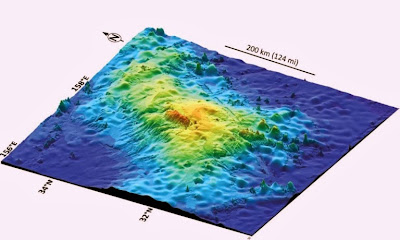The World's Largest Volcano Makes Sense in the Light of Global Catastrophe
The largest volcano in the world has been found.
"Found? How could someone miss it?"
Because it has been under water, a thousand miles east of Japan.
This bad boy belched out a huge amount of lava in a short time. But there is no need to worry, it has been inactive for a long time. Its eruption, lava flow and other underwater volcanic activity interferes with uniformitarian "the present is the key to the past" assumptions. Tas Walker explains in a biblical creationist global flood framework.
"Found? How could someone miss it?"
Because it has been under water, a thousand miles east of Japan.
 |
| NSF.gov |
A team of scientists led by William Sager at Texas A&M University reported finding the largest single volcano on earth. It is under the ocean and is now inactive.You can finish reading "The Tamu Massif, the largest single volcano on earth, erupted during Noah’s Flood", here.
Dubbed The Tamu Massif it is located about 1,600 km (1,000 miles) east of Japan, and is the largest feature of an underwater mountain range called Shatsky Rise.
Reports drew attention to the unusual shape of the huge lava deposit. The volcano is low and broad, a shield volcano. Most other volcanoes that erupt under the ocean are small with steep sides. The seafloor is dotted with thousands of such steep-sided underwater volcanoes, or seamounts.
The broad, flat shape means that the lava erupted at an enormous rate such that it travelled rapidly across the ocean floor as a fluid over long distances, before it was cooled sufficiently by the seawater such that it began to solidify and become viscous.
The volcano is ‘dated’ at 145 million years according to uniformitarian philosophy. This timing is based on the idea that everything happened slowly and gradually, and that the Noah’s Flood catastrophe never happened.